The average cost of ORIF in London approximately starts from USD 12000
Treatment cost
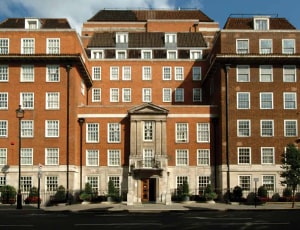
We, The London Clinic family, take pride in our reputation as a multi-disciplined healthcare facility. With skilled nurses and expert consultants, our medical teams are always focused to deliver the best individualized medical care. More than 1,000 nursing, clinical, and support staff are currently working with us to give our patients an extensive range of treatments. We use cutting-edge technologies to ensure a comprehensive range of healthcare services. Not only that, in order to make your stay with us comfortable enough, we equip our patient bedrooms with:
Patients from all over the world fly to us to get their procedures done by our specialist doctors, which is why we also provide our patient's concierge services. Our concierge services include:
The London Clinic has a zero-tolerance policy when it comes to hygiene and cleanliness. Our dedicated housekeeping team cleans every room every day between 8.00 am and 5.00 pm. They are also entitled to supply fresh towels every day and clean the rooms properly between patients.
We also have a day surgery unit based on the third floor at 20 Devonshire Place to make sure a hassle-free surgery as well as post-surgery care for our patients. Our cancer care unit at 22 Devonshire Place is also among our key services.
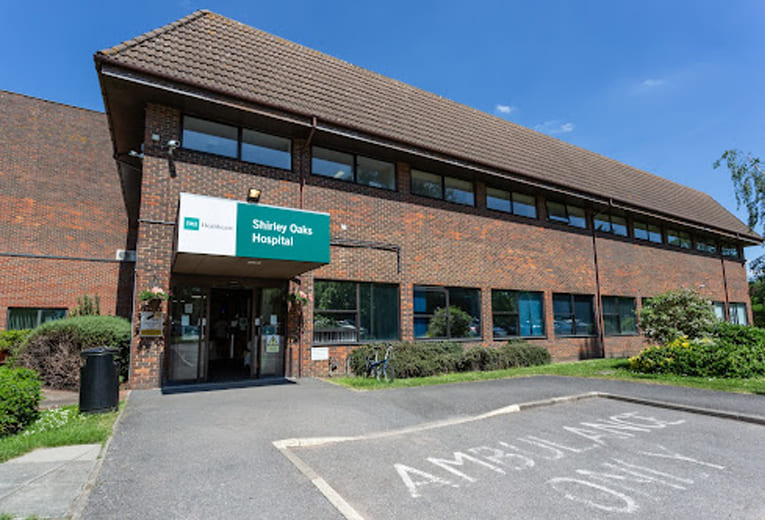
Shirley Oaks Hospital is a multispeciality hospital established in 1986 and is part of Circle Health Group. The hospital is located on the outskirts of Croydon in Shirley Oaks Village. The hospital offers a wide range of diagnostic and treatment services to patients allowing them to choose the services that they wish to avail in a hassle-free manner.
The hospital is a multispecialty facility that offers all types of treatments from 15+ specialties, including general medicine, ophthalmology, gastroenterology, and dermatology. Shirley Oaks Hospital is associated with 80+ consultants from within the UK.
The hospital offers services and treatments to patients under the age of 18 years and above.
Shirley Oaks Hospital offers a very warm and comfortable environment to the patients, from the moment they enter the building, whether for consultation or inpatient stay.
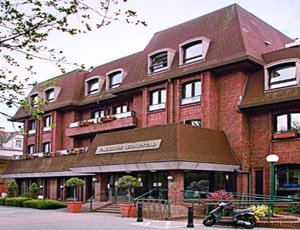
Apart from in-detail treatment procedures available, Parkside Private Hospital located in London, United Kingdom has a wide variety of facilities available for International Patients. Some of the facilities which are provided by them are Accommodation, Airport Transfer, Choice of Meals, Interpreter, SIM, TV inside room. Also listed below are some of the most prominent infrastructural details:

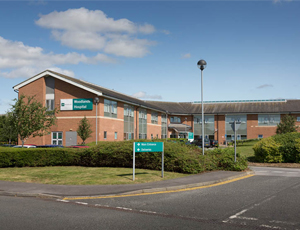
A 38-bedded hospital, Woodlands Hospital is supported by about 150 experienced doctors. It provides the highest standards of modern medical care and is BUPA accredited for its breast care services. All the staff at the hospital are totally committed to ensuring that patients are confident and comfortable with all aspects of their visit. It has resident medical officers available 24/7. Woodlands Hospital has an MRI scanner, an endoscopy unit, and a fully equipped gymnasium in addition to the two laminar flow theaters. It treats NHS-funded patients besides self-funding and insured patients. The hospital has access to the latest equipment and offers private facilities to patients in Richmond, Darlington, and Barnard Castle.
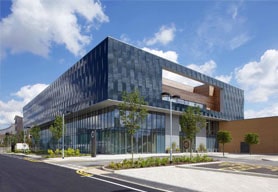
Circle Reading Hospital is a multispecialty hospital located in Reading, Berkshire. The infrastructure of the hospital is such that the patient is exposed to the luxurious and friendly environment and not something that seems daunting to them. The hospital offers a wide range of diagnostic and treatment services circle Reading Hospital is a multispecialty hospital located in Reading, Berkshire. The infrastructure of the hospital is such that the patient is exposed to the luxurious and friendly environment and not something that seems daunting to them. The hospital offers a wide range of diagnostic and treatment services to its patients, allowing them to choose the services that they wish to avail themselves in a hassle-free manner.
Keeping the quality in mind that the patient demands, the hospital has associated itself with some of the best consultants from Berkshire. The presence of some of the most experienced specialists from varied backgrounds, allows the hospital to have an environment that ensures the best possible clinical care for the patients.
The hospital offers treatment across 15+ specialties and some of the most popular treatments are offered for hip, knee, back, foot & ankle, gastroenterology, gynecology, shoulder & elbow, and gastroenterology.
Circle Reading Hospital offers a very warm and comfortable environment to the patients, from the moment they enter the building, whether for consultation or inpatient stay.
Facilities Provided:
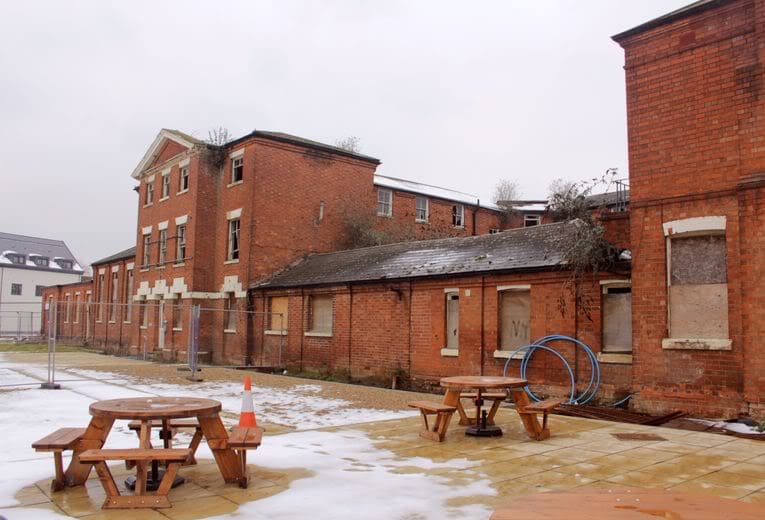
St Edmund Hospital has 26 beds with all rooms offering the privacy and comfort of en-suite facilities, views of the gardens, TV, and high-speed Wi-Fi. The hospital has three functional Operation Theatre for minor or major surgeries
The hospital has an imaging department and physiotherapy team based at the hospital to ensure the best care before and after treatment. The Hospital has a dedicated day case recovery area where patients can relax after day case procedure until discharged from the hospital.
Room service is provided to all inpatients by our catering team. All dietary needs can be catered for at the hospital.
The hospital has car parking spaces around the grounds, with a drop-off bay and disabled spaces directly opposite the entrance to the main hospital entrance.
The hospital has all the needed facilities, the latest in technology, and on-site support services; The hospital offers a wide range of procedures from routine investigations to complex surgery.
St Edmunds Hospital has more than 50 consultants who are experts and are s supported by caring and professional staff, dedicated nursing teams, and Resident Medical Officers on duty 24 hours a day, providing care within a friendly and comfortable environment.
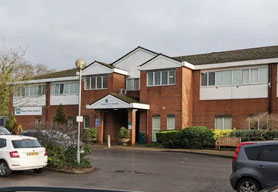
Bishops Wood Hospital is a 42 bedded acute care unit located in Middlesex, UK. Offering treatment and diagnostic services for more than 25 specialties, the hospital was established to offer the highest standard of care and services to patients from across the world. The hospital is a part of the private Circle Healthcare Group, which is a leading provider of state-of-the-art healthcare services and has multiple hospitals and clinics across the world.
The hospital has over 120 specialists and surgeons working with them to provide a variety of surgical and non-surgical treatments to people. The hospital is particularly known for a variety of orthopedic procedures that are carried out, including knee and hip surgery, hand and wrist surgery, foot and ankle surgery, and shoulder and elbow surgery. The hospital has been instrumental in slowly expanding its medical service and now offers treatments to patients requiring primary, secondary as well as tertiary care.
The hospital boasts of its team of medical and nursing staff, which is available 24 hours a day. Every medical specialist is a part of a multidisciplinary team, which includes specialists from the in-house radiology and physiotherapy department.
Facilities Provided:
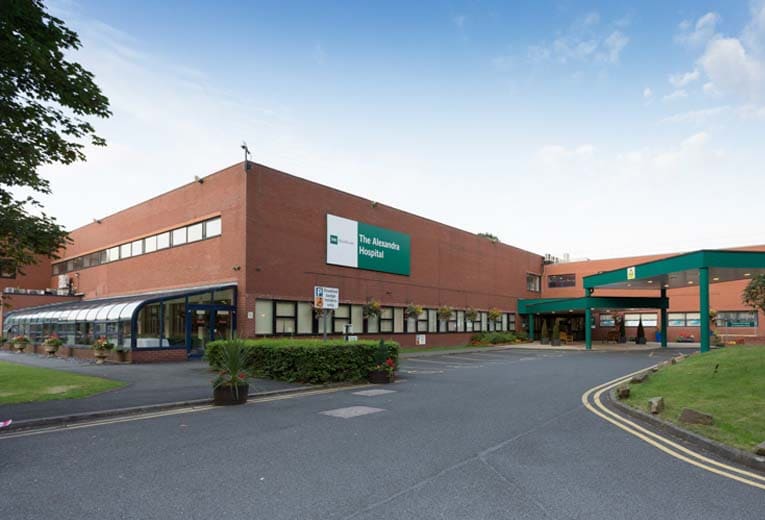
The Alexandra Hospital has access to modern equipment and private facilities for patients in Manchester, Stockport, and Cheshire. The hospital offers Outpatient Services to children from 0-18 years and day-case inpatient procedures for 3-18 years.
Established in 1981, the hospital is a 128-bedded facility offering treatments in more than 20+ specialties. The hospital has a friendly and caring staff. Equipped with world-class technology, the hospital is known for safe and effective outcomes across a wide range of treatments-from complex cases to minor surgery.
The Alexandra Hospital has dedicated radio imaging and biochemistry departments offering a wide range of tests being performed like X-ray, Ultrasound, CT Scan, MRI, DEXA Scan, etc.
The hospital ensures patient safety and provides an ideal environment with trained and experienced staff and a resident team available for 24 hours.
The hospital has efficient patient care that works hard to make each patient's time as pleasant as possible.
Open reduction internal fixation (ORIF) procedure aims at fixing a bone fracture that is considered to be very serious and in case realignment of the bone to the normal position is required with the help of screws, plates and other equipment.
ORIF surgery is a common procedure and is applicable for different bone segments of the body, including the hip, knee, arms, and thighs. ORIF surgery is performed by orthopaedic surgeons who have specialization in the musculoskeletal structure of the human body.
ORIF surgery is performed to stabilize the broken bone, which could be in any part of the body. The following are some of the common conditions that are treated with the help of an ORIF surgery:
● The bone pieces such as knee, hip, tibia-fibula, humerus, and femur are significantly out of alignment
● The bone pieces are piercing out through the skin
● The part of the bones in the above-mentioned parts of body is fractured, leading to formation of several pieces
● The fracture involves a knee joint
● The healing of the bones is not normal even after undergoing conservative treatment
Open reduction means open surgery aimed to set the bones as may be necessary after a fracture, while internal fixation means fixing of plates or screws and intramedullary bone nails in the case of humerus, tibia or femur bones to facilitate in the overall process of healing.
Micro motion across the lines of fracture is prevented with rigid fixation which not only helps promote healing but also prevents further infection which can happen when plates such as dynamic compression plates are used as implants.
Once the patient is under the influence of anesthesia, an incision is made at the site of the injury or the break and then the fracture is carefully realigned or the joint is replaced with extreme precision. The hardware required will be installed and the incision made will be closed with the help of stitches and staples. The inserted implants such as rods, pins, screws, and plates are permanent in many cases. In some cases, the implants are temporary and can be removed when the healing begins.
A cast is usually applied after ORIF surgery. Later when the healing process has sufficiently progressed, this cast will be replaced with something that is capable of bearing better weight than that. The cast is completely removed after a few weeks of the ORIF surgery. The following are the different types of ORIF procedures, depending on the locations of the fracture:
Occasionally cerclage wiring is used alone or in combination with a tension band wiring. If the surgeon allows, then K-wires can also be used. The reduction is checked by palpating the retropatellar surface (which requires a small arthrotomy) while the cerclage is tightened with the knee in extension.
The proximal pin ends are bent after the cerclage is tightened. They are further shortened and turned towards the quadriceps tendon and then it is driven into the patella to prevent any skin irritation and further loosening.
To remove sharp points, the distal pin ends are trimmed but then it is not bent for the purpose of easy removal. Two twists can be preferred by some surgeons to tighten the cerclage wire. But then they have to take extra care to ensure that no extra prominent wires are left protruding.
As the wires get twisted, the surgeon pulls it away from the patella to have them tightened. To prevent fixation failure, the wires should be twisted at least 5 times. When stainless steel wires are tightened, they tend to lose the sheen of the surface and it can break with further tightening. Some care is taken to eventually have the twisted wire positioned deeper into the soft tissue muscle layers. This procedure is used to treat a fractured knee or a fractured patella.
ORIF surgery for the ankle is performed in the prone position and a bump is placed under the ipsilateral hip. The patient may also be placed in the lateral decubitus position if medial malleolus fracture is not present.
Just medial to the posterior border of the fibula bone, a longitudinal incision is placed which allows good access to the Volkmann’s fragment and to the lateral malleolus. The sural nerve and saphenous vein are identified and protected.
The anatomy of the sural nerve is highly variable and hence meticulous blunt dissection has to be performed in the subcutaneous tissue. To gain access to the posterior aspect of the lateral malleolus, the peroneal tendons must be retracted medially. With the help of a lag and an antiglide plate, the fibular fracture is fixed classically but the construct of the fixation can vary depending upon the comminution and the fracture pattern.
Limited contact dynamic compression plate or one-third tubular plate can be employed to give additional stability in complicated fracture patterns. The latter plate is contoured by having the corners narrowed at the distal end to fit closely over distal fibula’s posterior border.
Within the wound, a second interval is further exploited between the Achilles tendon and the peroneal tendon more medially. From the posterior tibia, the flexor hallucis longus is lifted up to allow access to the posterior malleolus. Via the perimalleolar arterial, ring blood is supplied to the tibia. The fracture edge must be defined and devascularization of the fragment should not happen. In order to supplement the fixation, a small buttress plate can also be employed.
Through a standard medial incision, the medial malleolus can be addressed, but this can be challenging in a prone position when compared to the supine position due to the tendency of the leg to rotate externally. Hence it is good to have an assistant to hold the lower limb in case of internal rotation. Usually, with the help of two of the 3.5 lag screws, fixation of the medial side will be carried out.
Supracondylar fractures are common among femur fractures occurring proximal to the knee joint in the terminal of the femur in between the metaphyseal-diaphyseal junction and the femoral condyles. ORIF femur includes treatment of the fracture by incorporating intramedullary nails, plates and external fixators or total knee arthroplasty. The technique adopted will depend upon the bone quality and hemodynamic stability of the patient.
The angled blade plate of 95 degrees is a one-piece fixed angle device having a blade to be inserted in the condyles distally. But condylar screw system is much easier to use than angled blade plate. In the plate position, sagittal plane adjustments can be made which is not possible with blade plate. With an intercondylar split, the condylar screw is able to provide interfragmentary compression for the fractures.
With a cloverleaf distal portion that can be contoured, the condylar buttress plate is broad and can fit the lateral aspects of the distal femur. For the purpose of minimally displaced fractures, it can be used and most useful when fractures with articular extension in the sagittal and coronal planes have to be addressed. It is also used as an intraoperative backup device when some amounts of difficulties are faced while using the condylar screw system or the angled blade plate. In LISS or the less invasive stabilization system, a locking plate and a screw construct are used which ensures the preservation of the periosteal blood supply to the fracture. LISS plate is more useful in the case of osteoporotic bone.
The broken parts of the femur bone at the neck are put back in this surgery. The incision is made in the hip to view the damaged bone. The femur is straightened and broken pieces of the bone are put together.
Special metals, bars, plates, rods, screws can be used to keep the broken pieces together. An artificial implant may be placed to have the head of the femur specifically replaced. If the hip joint is also injured, an implant is placed to replace the hip socket too.
One of the main components of recovery is pain management after ORIF surgery. ORIF recovery time varies from one patient to the other, It also depends on the exact location of the surgery. ORIF ankle surgery recovery time is different from that of ORIF surgery of the hip. Recovery is typically painful and hence proper pain management is required after the ORIF surgery. Acetaminophen and codeine are usually prescribed. Research results reveal that ibuprofen or other kinds of nonsteroid anti-inflammatory drugs can slow down the process of healing during the recovery period. So these should be avoided during the recovery period.
Healing regimen physical therapy is also introduced during the recovery period since the body part that suffered the trauma will be held in an immobilized position for a very long period of time. As a result, the tendons, ligament, and muscles may grow weak with time.
With physical therapy, the strength comes back and endurance of the affected area increases with a range of motion. Physical therapy includes exercises, nerve stimulation, cold and hot packs, and ultrasound.
Ask your healthcare adviser for the best multiple options and choose the one that meets your expectations
On an average, ORIF in London costs about $12000. ORIF in London is available across many hospitals in different states.
ORIF package cost in London has different inclusions and exclusions. The ORIF package cost usually includes all the expenses related to pre and post surgery expenses of the patient. The treatment cost usually includes the expenses related to hospitalization, surgery, nursing, medicines, and anesthesia. Extended hospital stay, complications after the surgery or new diagnosis may affect the overall cost of ORIF in London.
There are many hospitals across the country that offer ORIF to international patients. The following are some of the most renowned hospitals for ORIF in London:
Upon discharge from the hospital after ORIF in London, the patients are advised to stay for about 12 days for recovery. This period is important to conduct all the follow-up tests to ensure that the surgery was successful and the patient can go back to the home country.
One of the topmost destinations for ORIF is London. It has a variety of accredited hospital, affordable cost of treatment and some of the best medical fraternity. there are a select few destinations that provide comparable quality of healthcare for the procedure. Some of such cities are:
Apart from the ORIF cost, the patient may have to pay for additional daily expenses such as for guest house after discharge and meals. These charges may vary from 55 USD per person.
After the ORIF surgery takes place, the average duration of stay at the hospital is about 2 Days. During the recovery, the patient is carefully monitored and control tests are performed to see that everything is okay. If required, physiotherapy sessions are also planned during recovery in hospital.
There are about 3 Hospitals in London that offer ORIF to international patients. These hospitals are approved to perform the surgery and have proper infrastructure to handle ORIF patients. Apart from good services, the hospitals are known to follow all standard and legal guidelines as dictated by the local medical affairs body or organization.
Some of the most sought after doctors for ORIF in London are: